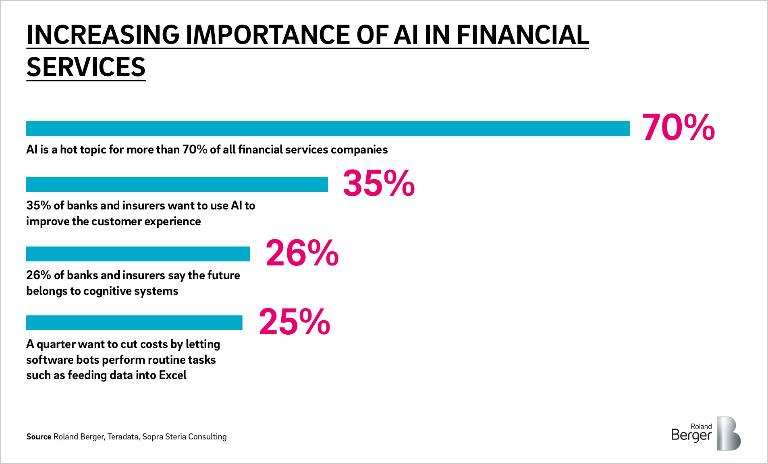

Artificial intelligence to turbo-boost the financial sector
End-to-end digitalization and platforms continue to gain importance
Banks and financial service providers can use AI as a tool to make many of the links in their value chain more efficient and as a means to counteract shrinking margins and growing competition and keep their business profitable.
Artificial intelligence, or AI for short, is actually nothing new: fundamental research into neural networks was going on as early as the 1960s. But it's since 2015 that the topic has become increasingly relevant to the financial service sector. Polls like our own "Retail Banking Survey" have shown that while end-to-end digitalization and platforms are the crucial issues for financial service providers today, the subject of AI is definitely gaining in importance. And there is a certain amount of catching up to do in many cases, given the dramatic acceleration in the pace of developments lately. For one thing, the technical requirements for the use of artificial intelligence are by and large already in place, with today's computers offering much faster processors for much lower prices. And for another, access to computing power is now considerably easier over the cloud. Not to mention another factor that's particularly crucial for the financial sector, which is that the necessary data – especially from the capital market side but also companies' own data – are readily available these days.

New tools for a changed sector
The financial industry continues to face considerable pressure to change. Shrinking margins not only mean that providers have to cut costs and efficiently manage risks, but they also make it essential to tap new sources of revenue as well. Added to that, the growing regulatory burden necessitates more powerful analytical tools to enable the financial sector to be comprehensively monitored in reporting terms and the legal requirements to be met with regard to things like AML compliance checks.
AI applications are the efficient tools of choice here and can be applied at many points along the value chain. For example, image recognition can be used at the customer interface as part of the authorization process, and voice recognition allows chat bots to be deployed in customer consultations. AI can help with credit checking and rating in equal measure. Hedge funds and stockbrokers also use the technology to detect higher and therefore uncorrelated yields or to improve their trading activities. Further, AI tools can help financial institutes draw up their supervisory review report and can be applied for data analysis and optimization as well as fraud detection and prevention purposes.
Opportunities and risks
In view of the many possible applications out there, every company in the financial sector would do well to systematically review its value chain for AI options, evaluate potential risks and manage appropriately. The advantages for companies and for their customers are manifold:
- AI tools improve the quality of data and dramatically increase the speed of data processing: estimates indicate that the saving could be in the order of a quarter to a half of the time it takes to do the same processing today.
- AI improves credit checking and reduces the cost of risk accordingly, with a 10 to 15 percent reduction being par for the course.
- New types of consultation provided on the basis of artificial intelligence – with chat bots, for example – make customer service more efficient and more innovative. Used right, AI tools can help companies win market share and earn additional revenues.
- Personnel costs are reduced, since AI technologies automate many processes or restrict the amount of human effort required.
That said, we must not pretend that the growing application of artificial intelligence brings nothing but opportunities. There are risks involved, as pointed out by the Financial Stability Board in a publication last November. One of the risks lies in the fact that self-learning algorithms are not auditable and, more importantly, the industry is increasingly dependent on third parties that operate outside of the regulatory framework. Plus there is the danger that comes from the growing interconnectivity between the financial market and the banks, which can result in systemic risks. For as we know, it was algorithms that manipulated the volatility index and caused the New York stock exchange correction back in early February, from which the banks themselves suffered significant losses. That is why the Financial Stability Board is calling for rigorous testing, with clean data and feedback mechanisms, for all AI tools. With that in place, it will be possible to make sure that the technology actually does what it's supposed to and can be used for the benefit of all.




